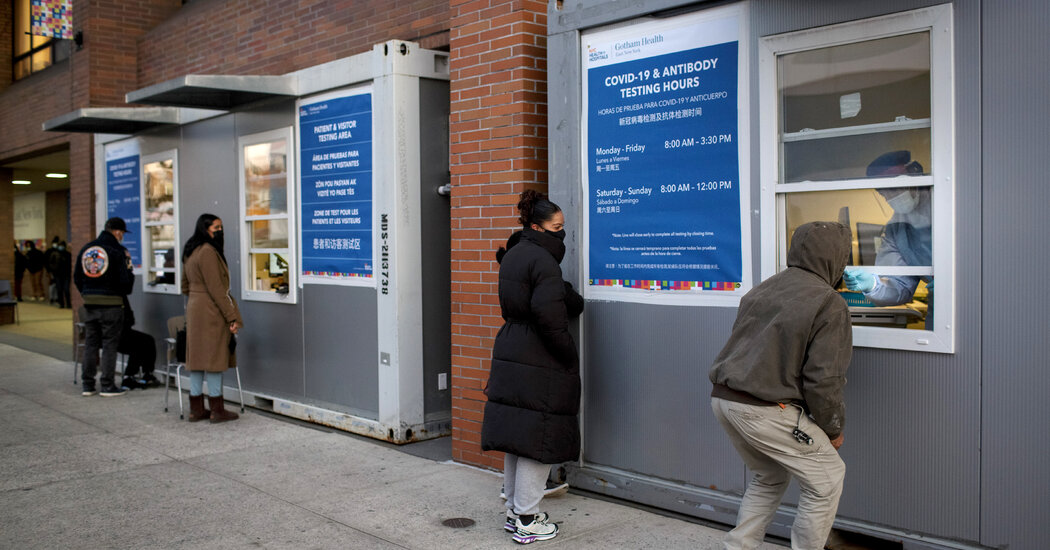Some of the timeliest data on Co-19 outcomes by vaccination status comes from New York City and the Seattle area, and the two are telling a consistent story.
Cases for vaccinated and unvaccinated residents alike are rising:
They’re rising because vaccination often does not prevent infection from the Omicron variant. It reduces the chances substantially — as you can see above — but vaccinated people still face a meaningful chance of infection.
What vaccination does is radically reduce the chance of severe Co illness. Look how different these charts on hospitalizations looks from the previous charts on cases:
(The number of Americans hospitalized with Co has surpassed last winter’s peak.)
Some experts believe that the hospitalization gap between the vaccinated and unvaccinated is even larger than these charts suggest. The official data on Co hospitalizations includes many people who are hospitalized for other reasons — say, a heart condition or a bicycle crash — and who test positive for the virus while being treated.
About one-third of Co hospitalizations fall into this category, according to a recent analysis at the University of California, San Francisco. In New York State, 43 percent of people hospitalized with Co were admitted for other reasons.
It’s true that some of these incidental Co hospitalizations still cause problems. The virus can harm people whose bodies are weakened by other medical conditions, and all Co cases put added stress on hospitals, because patients must be isolated. (“Hospitals are in serious trouble,” Ed Yong writes in The Atlantic.)
Still, many incidental Co cases in hospitals do not present much risk to the infected person. And Omicron is so contagious that it has infected many vaccinated people, likely inflating the hospitalization numbers more than previous variants have.
The death gap
The data on deaths from New York and Seattle underscores the relatively low risks for vaccinated people. These numbers show a starker gap between the vaccinated and the unvaccinated than the hospitalization data:
One caveat is death trends tend to lag case trends by about three weeks. In coming weeks, deaths among the vaccinated will almost certainly rise, given how sharply cases have risen. These deaths will likely be concentrated among people in vulnerable health, including the elderly and those with a serious underlying medical condition like a previous organ transplant — especially if they’re not boosted.
This likelihood — along with the problem of overwhelmed hospitals — is one of the strongest arguments for taking steps to reduce the size of the current Omicron wave. More vaccine mandates and indoor mask wearing can help reduce cases and, by extension, deaths, experts say.
But the early data raises the possibility that the increase in deaths among the vaccinated will remain relatively modest. The gap in the mortality charts above can’t merely be a reflection of the lag between the cases and deaths. After all, deaths among unvaccinated New Yorkers and Seattleites had already begun to surge in December. Deaths among the vaccinated had not.
(In Boston and Chicago, Co deaths have also risen, these charts show.)
The bottom line
Vaccination remains highly effective at preventing severe Co illnesses. And Omicron is milder than earlier versions of the virus. The combination means that most Americans — including children and vaccinated adults — face little personal risk from Omicron.
The risk is not zero, to be clear, even among people who are generally healthy. But it is very small. Every day, people live with small risks, be they from the seasonal flu and other illnesses or from riding in a vehicle, playing sports or other activities.
For the unvaccinated, the situation is very different. Omicron is still severe enough that it will lead to debilitating illness and death for many unvaccinated people. In much of the U.S., a large number of adults — including older adults — remain unvaccinated:
Georgia Beats Goliath
It’s been a good year for Georgia sports. Atlanta won the World Series. The Hawks made the Conference Finals. And last night, Georgia beat Alabama, 33-18, to win college football’s national championship.
Georgia’s stifling defense, which was the best in college football all season, intercepted Alabama’s quarterback in the final minute and returned it for a touchdown to seal their first title in more than 40 years.
The Coronavirus Pandemic: Key Things to KnowCard 1 of 5
Vaccine mandates. The Supreme Court blocked the Biden administration from enforcing a vaccine-or-testing mandate for large employers, but the justices allowed a more modest mandate requiring health care workers at facilities receiving federal money to be vaccinated.
Around the world. The future of British Prime Minister Boris Johnson is in doubt after he admitted attending a party that violated lockdown rules. In France, teachers staged a one-day walkout against relaxed Co testing rules that they fear will lead to more infections.
Georgia spent years in the long shadow of its neighbor. Alabama has been to nine championship games since 2010, and won six. Georgia hadn’t beaten Alabama once in those years. Its head coach, Kirby Smart, had never beaten his former boss and mentor, Alabama’s Nick Saban.
But Georgia was no underdog. Both teams are among college football’s elite — they faced off in a championship game just four years ago — and Georgia entered the season with the country’s best recruiting class.
“Top-tier recruits quite often choose schools with histories of contending for championships, so the Alabamas and Georgias of the world more or less reload annually,” our colleague Alan Blinder, who covers college sports, told us. Don’t be surprised if you see one, or both, back in the title hunt next year.
For more: Here’s how Georgia won. — Tom Wright-Piersanti, a Morning editor



